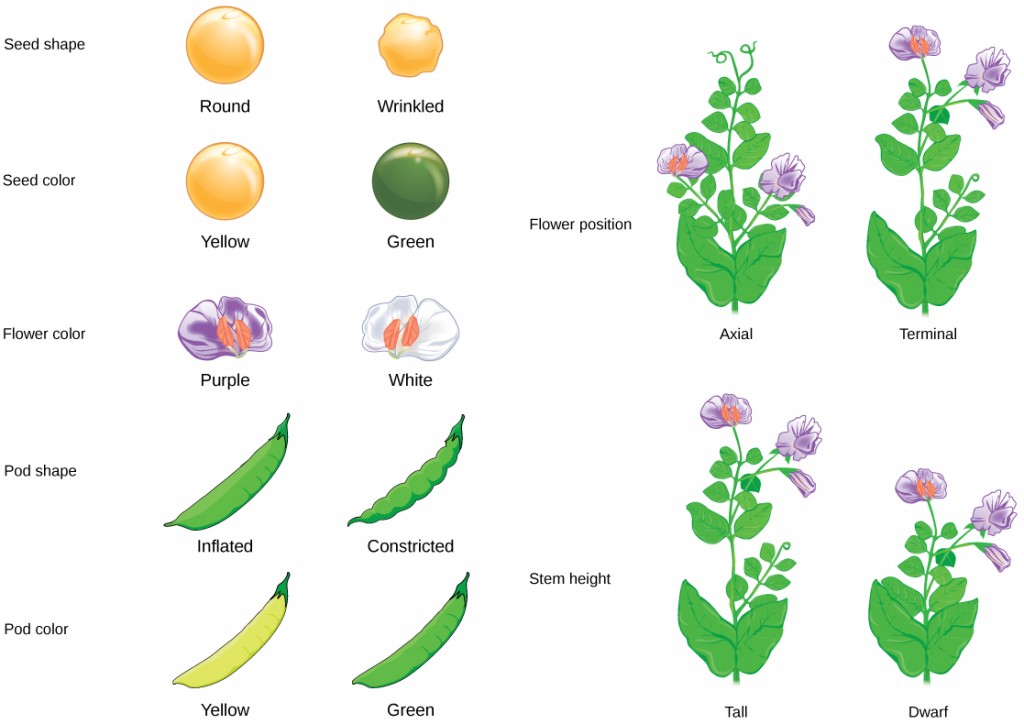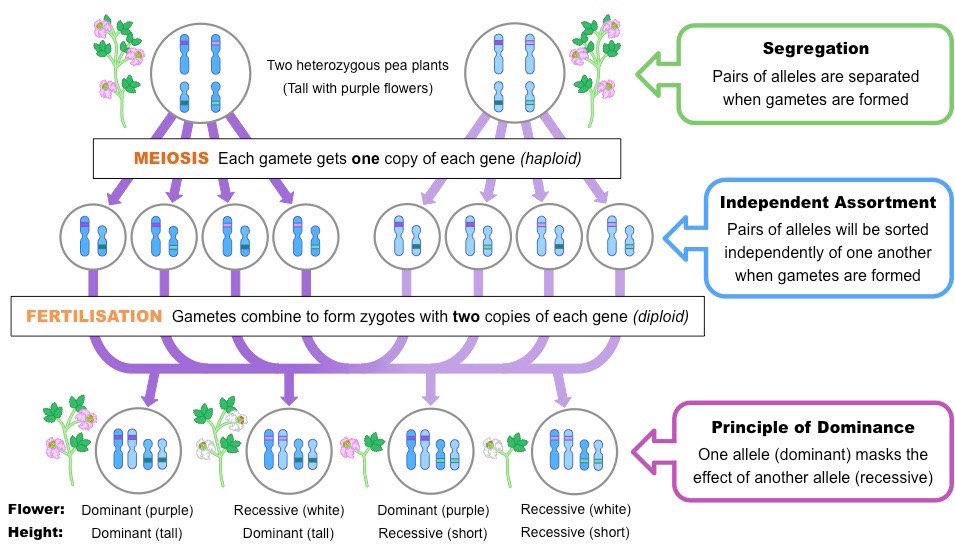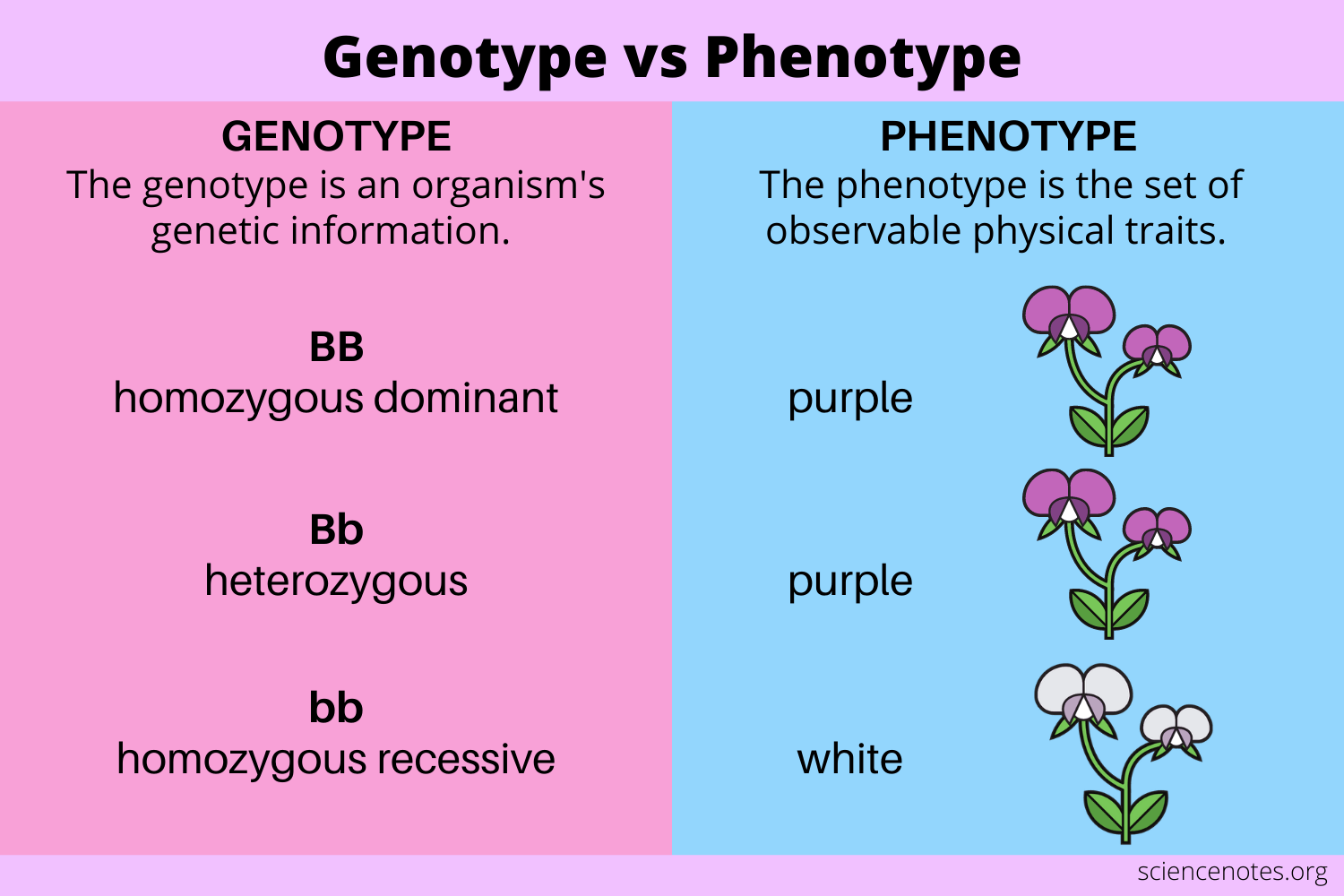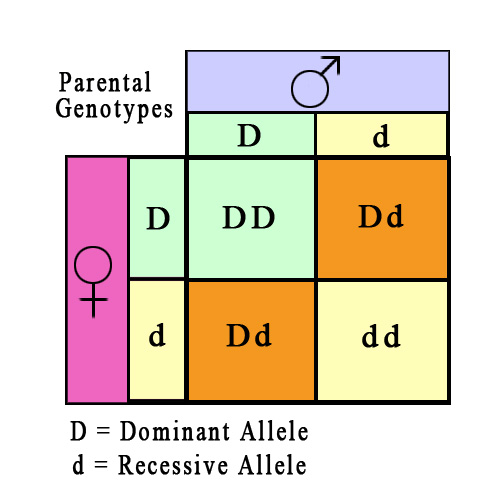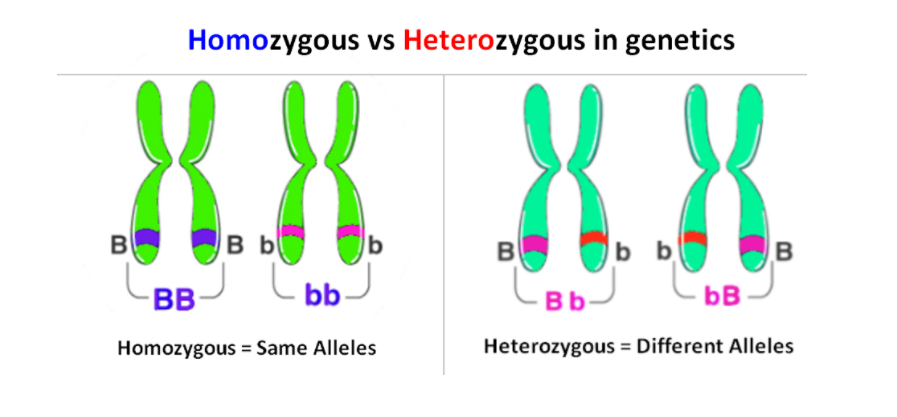Mendelian Genetics Study Guide
Introduction:
Mendel concluded that heredity is related to a discrete inheritance unit and that every single gene or unit was independent of its actions in any individual genome. The inheritance of a trait is dependent on the passing of this unit. For a given trait, the individual inherits one gene from each of the parents so that the individual now has two gene pairs.
Mendel proposed that the traits are controlled by a single gene only. Modern studies, however, point to the fact that several genes control the traits in humans. It is also affected by environmental influences.
Result of Mendel’s experiment
- Mendel had carried out breeding experiments to understand the pattern of inheritance. He cross-bred the common pea plants with the selected traits over many generations.
- After he crossed the plants that differed in a single trait, say tall vs. short stem or round vs. wrinkled peas, Mendel discovered about the next generation, which is the F1 generation, comprised of individuals that exhibited just one trait.
- When this generation was further interbred, the offspring of F2 had a 3: 1 ratio, which means that 3 had the same trait as a single parent, and one of them had the trait of the other parent.
- Mendel theorized that genes are made up of three possible hereditary units or pairings, which were called factors. These are AA, Aa and aa. The big A indicates the dominant factor; the little a represents the recessive factor.
- In the Mendel’s cross, the plants started with the homozygous type, AA or aa. The F1 generation was Aa, and the F2 generation was Aa, AA, or aa. The interaction between these determines what the physical trait of an individual is.
- This is predicted through Mendel’s law of dominance. It says that when mating happens between two organisms with varied traits, each offspring will exhibit the trait of just one parent. If an individual has the dominant factor, this will result in the dominant trait. The precise trait is visible only when both the factors are recessive.
Mendel’s law of Inheritance and Traits
We can thus summarize the Mendel principle, which concludes with the following two laws or principles. These are Mendel’s law of segregation and independent assortment.
The Law of Segregation
Mendel’s law of segregation states that each parent’s gene pairing or alleles split for any individual trait, and one gene gets passed from each of the parents to one offspring. Which gene will get passed on is purely based on chance, which is the principle of segregation.
The Law of Independent Assortment
This law states that the different allele pairs get passed independently. The offspring thus have varied allele pairs. Inheritance of genes in one location in a genome does not influence gene inheritance at some other location.
So you can now compare the law of segregation vs. the law of independent assortment.
Mendelian Inheritance Terminologies
- Gregor Mendel discovered the particular inheritance or the hereditary element idea and passed it in discrete units.
- These do not get blended in every new generation.
- The discrete units are the genes.
- The gene is a hereditary factor, and it influences any particular trait. It is made of some specific DNA sequence located in any particular region or a particular chromosome.
- Since the gene has a particular location, it is also called the genetic locus.
- An allele is a variant of a gene, i.e., each gene has different forms.
- The genotype (an individual’s collection of genes) of an organism is the particular alleles collection that is found in the DNA.
- The observable physical properties of an organism such as height, eye color, and blood type is called the phenotype.
- An organism with two similar alleles for the particular gene is homozygous at that particular locus.
- An organism with two different alleles for any particular gene is heterozygous at that locus.
- The phenotype of the organism is its noticeable trait such as a dominant or recessive trait.
- The dominant allele will produce the dominant phenotype if the organism is homozygous dominant or heterozygous at the locus.
- The recessive allele produces the phenotype only when it is homozygous recessive, i.e., possess two identical recessive alleles of a particular gene or genes at the locus.
- At times there are specific recessive alleles that are associated with a disease.
- The Punnett square is a table in which all of the possible outcomes for a genetic cross between two individuals with known genotypes are given. An example of a Punnett square for pea plants is shown here:
Conclusion:
- Mendel used pea plants to figure out the inheritance pattern and understand the principles of Mendelian genetics.
- This helped to find out about several traits caused by a single gene with a simple recessive or dominant inheritance pattern.
- The alleles for varied traits are segregated independently from each other. This is the principle of independent assortment.
FAQs:
1. What are the 3 laws of Mendelian genetics?
- Law of dominance: In pairs of alleles that are different, one allele will mask the effect of the other allele
- The law of segregation: Each hereditary characteristic is controlled by two alleles which separate into different gametes
- The law of independent assortment: The separation of alleles for one gene is independent to allele separation for another gene
2. What are examples of Mendelian genetics?
- The inheritance patterns of single gene diseases are often referred to as Mendelian.
- Autosomal Dominant- Huntington’s disease
- Autosomal Recessive- Tay-sachs disease, sickle cell anemia
- X-linked Dominant- vitamin D-resistant rickets
- X-linked Recessive- Hemophilia A
3. What are Mendel’s 4 principles?
- Principles of Paired Factors: Inheritance involves the passing of discrete units of inheritance, or genes, that exist in pairs in individual organisms from parents to offspring.
- Principle of Dominance: In pairs of alleles that are different, one allele will mask the effect of the other allele
- Law of Segregation or Law of Purity of Gametes: Each hereditary characteristic is controlled by two alleles which separate into different gametes
- Law of Independent Assortment: The separation of alleles for one gene is independent to allele separation for another gene
4. What is the importance of Mendelian genetics?
The basic laws of inheritance are important in understanding patterns of disease transmission. An accurate family history of a particular disease will help establish a pattern of transmission thus maybe even help to exclude genetic diseases whereever possible.
We hope you enjoyed studying this lesson and learned something cool about Mendelian Genetics! Join our Discord community to get any questions you may have answered and to engage with other students just like you! Don’t forget to download our App to experience our fun, VR classrooms – we promise, it makes studying much more fun! 😎
Sources:
- The Mendelian Concept of a Gene. https://knowgenetics.org/mendelian-genetics/. Accessed 20 Dec, 2021.
- Mendelian Genetics. https://bioprinciples.biosci.gatech.edu/module-4-genes-and-genomes/4-2-4-mendelian-genetics/. Accessed 20 Dec, 2021.
- Mendel’s First Law of Genetics (Law of Segregation). https://www.ndsu.edu/pubweb/~mcclean/plsc431/mendel/mendel1.htm. Accessed 20 Dec, 2021.
- Mendelian inheritance. https://www.britannica.com/science/Mendelian-inheritance. Accessed 20 Dec, 2021.

